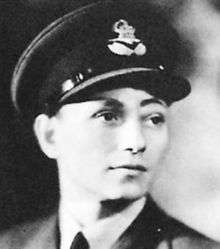Hugh Malcolm
Wing Commander Hugh Gordon Malcolm, VC (2 May 1917 – 4 December 1942) was a Scottish airman and a recipient of the Victoria Cross, the highest award for gallantry in the face of the enemy that can be awarded to British and Commonwealth forces.[1]
Hugh Malcolm | |
|---|---|
 | |
| Born | 2 May 1917 Broughty Ferry, Dundee, Scotland |
| Died | 4 December 1942 (aged 25) near Bizerta, French Tunisia |
| Buried | Beja War Cemetery, Tunisia |
| Allegiance | United Kingdom |
| Service/ | Royal Air Force |
| Years of service | 1936–1942 |
| Rank | Wing Commander |
| Commands held | No. 18 Squadron RAF |
| Battles/wars | Second World War |
| Awards | Victoria Cross |
Early life
Malcolm was born in Broughty Ferry, Dundee, and educated at Craigflower Preparatory School near Dunfermline and Glenalmond College in Perthshire. He entered the Royal Air Force College Cranwell on 9 January 1936. In January 1938, Malcolm joined No. 26 (Army Co-operation) Squadron at Catterick. In May 1939, he suffered a serious head injury in a Westland Lysander crash.
Second World War
When the war started, Malcolm was serving with No. 17 Training Group. On 4 March 1941, he was promoted to flight lieutenant and was Air Liaison Officer on Lieutenant General Bernard Montgomery's general staff.
By the end of 1941 Malcolm had risen to the rank of squadron leader and joined No. 18 Squadron as a flight commander, flying the Bristol Blenheim and based in Suffolk.
During late 1942 in North Africa, Wing Commander Malcolm assumed commanded of No. 18 Squadron, flying the Bristol Blenheim Mk. V light bomber. Throughout his service in that sector, his skill and daring were of the highest order. He led two attacks on Bizerta airfield in Tunisia, pressing his attacks to effective conclusion.
On 17 November 1942, the squadron were detailed to carry out an attack on Bizerta, taking advantage of low cloud cover. Twenty miles from the target, the sky cleared, but despite the danger of continuing without a fighter escort, Malcolm decided to go ahead. Despite fierce opposition, the mission was a success with all bombs dropped within the airfield perimeter, and a Junkers Ju 52 and Messerschmitt Bf 109 were shot down, with other enemy aircraft damaged on the ground by machine-gun fire.
Malcolm was a 25-year-old wing commander when the following deed took place for which he was awarded the Victoria Cross. On 4 December, he led a thirteen-strong attack on an enemy fighter airfield near Chougui, Tunisia. On reaching the target, however, and starting the attack, the squadron was intercepted by an overwhelming force of enemy fighters from I and II. Gruppen JG 53, and 11 Staffel, JG 2. One by one, all his bombers were shot down, until he himself was shot down in flames.[2]
Malcolm's aircraft crashed in flames some 15 miles west of the target. An infantry officer and two other men who arrived at the scene of the crash minutes later retrieved the body of navigator Pilot Officer James Robb. Malcolm, with Robb and gunner Pilot Officer James Grant, were buried in the Beja War Cemetery in a collective grave.[3] Malcolm was posthumously awarded the Victoria Cross on 27 April 1943. His was the first Royal Air Force Victoria Cross to be won in North Africa.
Legacy
The RAF's Malcolm Clubs were named in his honour. These were welfare clubs for RAF personnel, which operated in several countries between 1943 and the early 1970s,[4] although the club at RAF Wittering continued until the 1990s. They are mentioned in Queen's Regulations.
Malcolm's Victoria Cross is on display in the Lord Ashcroft collection at the Imperial War Museum, London.[5]
References
- Michael Ashcroft (2012). Heroes of the Skies. Hachette UK. ISBN 0755363914. Retrieved 10 November 2014.
- "No. 35992". The London Gazette (Supplement). 23 April 1943. p. 1905.
- CWGC entry
- "PROPOSED CLOSURE OF MALCOLM CLUBS". Hansard: House of Lords. 22 January 1959. Retrieved 10 July 2017.
- "Lord Ashcroft VC collection". Retrieved 13 March 2013.
External links
| Wikimedia Commons has media related to Hugh Malcolm. |
- Acting Wing Commander H.G. Malcolm in The Art of War exhibition at the UK National Archives